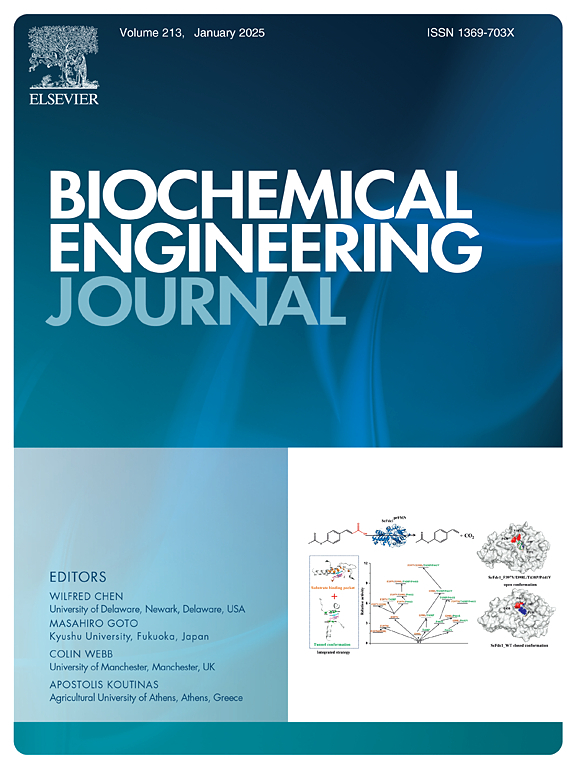基于固定微生物的改性沸石的混凝土裂缝自愈合技术
IF 3.7
3区 生物学
Q2 BIOTECHNOLOGY & APPLIED MICROBIOLOGY
引用次数: 0
摘要
通过微生物诱导碳酸钙沉淀技术实现混凝土自愈合的同时,选择合适的载体来保护微生物并提高其在基质中的存活率是一项挑战。在这项研究中,改性沸石被用作混凝土的微生物载体。使用不同浓度的酸碱试剂浸渍天然沸石,并确定了最佳改性试剂。分析了沸石与混凝土的机械相容性。通过分析混凝土裂缝试件的自愈合指数,评估了微生物的矿化功效,确定了改性沸石的最佳用量。并探讨了该系统的机理。结果表明,当细菌溶液浓度为 3×107 cfu/mL 时,在 0.4 mol/L HCl 溶液中加入改性沸石(粒径:1.0-2.0 mm)可获得最佳的微生物固定和矿化效果。此外,在沸石用量相等的情况下,改性沸石自修复混凝土的抗压强度恢复能力可提高 8-22%,吸水率降低 11-20%,使其能够完全修复较宽的裂缝。改性沸石含量分别为 30% 和 40% 的混凝土试样表现出优异的性能,其中 40% 的改性沸石含量表现出最高的自愈合能力。在改性沸石掺量为 40% 的情况下,混凝土在 28 天时的抗压强度恢复率高达 86.8%,吸水率为 5.4%,可有效修复宽度达 0.5 毫米的裂缝。本文章由计算机程序翻译,如有差异,请以英文原文为准。
Self-healing of concrete crack based on modified zeolite immobilizing microorganisms
Selecting the appropriate carrier to safeguard the microorganisms and enhance their viability within the matrix while implementing self-healing in concrete by microbial induced calcium carbonate precipitation technology is challenging. In this study, modified zeolite was used as the microbial carrier for concrete. Varying concentrations of acid and alkali reagents were used to impregnate natural zeolite, and the optimal modification reagent was identified. The mechanical compatibility of zeolite and concrete was analyzed. The mineralization efficacy of microorganisms was assessed by analyzing the self-healing indices of concrete crack specimens, the optimal dosage of modified zeolite was determined. And the mechanism of this system was explored. The results indicate that when the bacterial solution concentration is 3×107 cfu/mL, incorporating modified zeolite (particle size: 1.0–2.0 mm) with a 0.4 mol/L HCl solution yields the optimal microbial immobilization and mineralization effects. Also, with equivalent zeolite dosage, modified zeolite self-healing concrete can enhance compressive strength recovery by 8–22 % and reduce water absorption by 11–20 %, making it capable of completely repairing wider cracks. Concrete specimens with 30 % and 40 % modified zeolite content demonstrated excellent performance, with the 40 % dosage exhibiting the highest self-healing capability. At the 40 % modified zeolite dosage, concrete achieved a remarkable 86.8 % compressive strength recovery at 28 days and a 5.4 % water absorption rate, effectively repairing cracks up to 0.5 mm width.
求助全文
通过发布文献求助,成功后即可免费获取论文全文。
去求助
来源期刊

Biochemical Engineering Journal
工程技术-工程:化工
CiteScore
7.10
自引率
5.10%
发文量
380
审稿时长
34 days
期刊介绍:
The Biochemical Engineering Journal aims to promote progress in the crucial chemical engineering aspects of the development of biological processes associated with everything from raw materials preparation to product recovery relevant to industries as diverse as medical/healthcare, industrial biotechnology, and environmental biotechnology.
The Journal welcomes full length original research papers, short communications, and review papers* in the following research fields:
Biocatalysis (enzyme or microbial) and biotransformations, including immobilized biocatalyst preparation and kinetics
Biosensors and Biodevices including biofabrication and novel fuel cell development
Bioseparations including scale-up and protein refolding/renaturation
Environmental Bioengineering including bioconversion, bioremediation, and microbial fuel cells
Bioreactor Systems including characterization, optimization and scale-up
Bioresources and Biorefinery Engineering including biomass conversion, biofuels, bioenergy, and optimization
Industrial Biotechnology including specialty chemicals, platform chemicals and neutraceuticals
Biomaterials and Tissue Engineering including bioartificial organs, cell encapsulation, and controlled release
Cell Culture Engineering (plant, animal or insect cells) including viral vectors, monoclonal antibodies, recombinant proteins, vaccines, and secondary metabolites
Cell Therapies and Stem Cells including pluripotent, mesenchymal and hematopoietic stem cells; immunotherapies; tissue-specific differentiation; and cryopreservation
Metabolic Engineering, Systems and Synthetic Biology including OMICS, bioinformatics, in silico biology, and metabolic flux analysis
Protein Engineering including enzyme engineering and directed evolution.
 求助内容:
求助内容: 应助结果提醒方式:
应助结果提醒方式:


